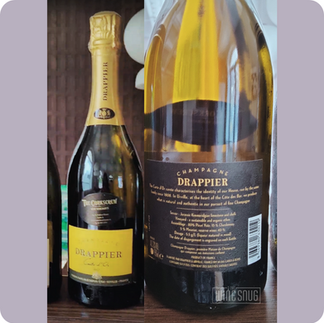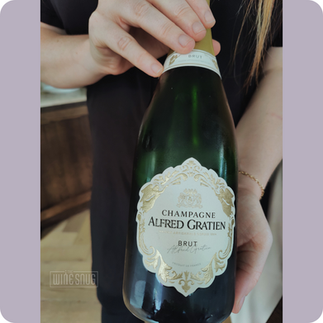Champagne Masterclass
- Ara Esparza

- May 23, 2023
- 6 min read
Updated: May 26, 2023
I attended a champagne masterclass organised by Wine & Spirit Women and boy, was I happy! Not only because we tasted 11 different champagnes -although that helped!- but mainly because I learned new things about my favourite bubbles, the ultimate queen: Champagne.
Since my last trip to Reims and Épernay, all I can think about is champagne. So this was the perfect opportunity to deepen my knowledge. If you need a refresher on champagne terms or a run through the basics make sure to read the Champagne Savvy article.
My tasting notes for the champagnes we had are at the end of this post. I've included a nice pairing suggestion for each, let me know in the comments what do you think about these pairings. And if you need help when experimenting with these, I'm here to help you sip and munch *wink, wink*.
If you want to jump straight to the tasting notes, click on each of the champagnes below, otherwise, read on to get the best bits of the master class.
The Master Class
You know I don't gatekeep so here are the highlights of the masterclass. Let's start with some numbers about sparkling wine - remember, champagne is a sparkling wine but not all sparkling wine is champagne *Bien sûr*
▫️ Europe produces 80% of the sparkling wine worldwide *mic drop*
▫️ If we rank the top 5 European countries by their sparkling wine production, you will be shocked to read who made the cut in 5th place. Here's the rank:
1. Italy - Prosseco & Franciacorta, we are looking at you!
2. France - Champagne, cremant, give us all!
3. Germany - Sekt
4. Spain - Cava
5. Russia (picking up my jaw from the floor. Have you tasted this? asking for a friend)
New things I learned about Champagne
Can you guess which are the top 3 markets for champagne export? I was surprised to find that the largest market for it is the UK, tbh I was expecting a larger market in terms of land size, every day is a school day. Here are the top 3 export markets:
1. The UK
2. USA
3. Japan
A 'marc' is a traditional unit of measurement for a press-load of grapes and it's equal to 4 tones of grapes.
From that amount (a marc), there are roughly 2.5 tons of must.
From those, about 2 tons are the first pressed, which creates the finest juice.
The remaining 0.5 ton is for the second press which has less quality. Some champagne producers use only the first press juice.
Back in my Champagne Essentials article, I explained that there are 7 official grapes allowed to be grown at the Champagne appellation, but 3 varieties amount to 99% of the varietals grown: Chardonnay, Pinot Noir & Pinot Meunier. During this masterclass, I learned that the Queen B of Champagne (in terms of growth) is Pinot Noir, accounting for ~38% of grapes in the region. Pinot Meunier and Chardonnay have similar numbers with each having ~31% of growth share.
The best size bottle for ageing champagne? A Magnum! If you need a refresher on bottle names & sizes I got you. Read it here, you can also download the infographic.
Now, off to the (even more) fun part, the tasting!
For a refresher on the aromas & flavours that each of these 3 grapes provides to the champagne, read the Champagne Savvy article under the Aromas & Flavours section.
The Tasting - cin, cin
This masterclass was focused on Non-vintage, Brut, champagnes that are available for purchase in Ireland -yes, we are a small island and sometimes is good to read about wines that we can actually buy here! The best part, these are available internationally so you are likely able to find them in a wine store near you.
I loved that the tasting order was based on the ageing time of each champagne, starting from less time to more ageing time.
These are the 11 champagnes we tasted:

Brut Prestige Rosé. J. Charpentier. 12% abv.
🍇 Assemblage:
60% Pinot Noir
20% Chardonnay
20% Pinot Meunier
🍾 Dosage: 5.6 g/L
👄 Tasting notes: bright salmon colour, with nice acidity and notes of cherries and toast with a delicate mousse.
🫶 Food pairing: This is a fab champagne for an apéritif or for that romantic night with a bowl of strawberries. *insert sexy music here*

J. Charpentier. Blanc de Blancs. 12% abv.
🍇 Assemblage:
100% Chardonnay
🍾 Dosage: 5.7 g/L
👄 Tasting notes: this is a pale lemon champagne, with notes of white flowers and a nutty undertone. It has been aged in the cellar for 24 months, it is fresh and lively.
🫶 Food pairing: this champagne with oysters is giving *chefs kiss*

Special Cuvée. Bollinger. 12% abv.
🍇 Assemblage:
60% Pinot Noir
25% Chardonnay
15% Pinot Meunier
🍾 Dosage: 7-8 g/L
👄 Tasting notes: 85% of the grapes in this champagne come from Grand and Premier Crus which is not common for non-vintage champagne, making it a real treat. This is a light gold champagne, with notes of brioche, apple and a hint of citrus. This champagne is elegant and has a delicate mousse with a pleasant finish.
🫶 Food pairing: This is a crowd-pleaser and our favourite on the day. Grilled fish, lobster and because of the prominence of Pinot Noir, we would even go for charcuterie!

Brut Majeur. Ayala. 12% abv.
🍇 Assemblage:
55% Chardonnay
30% Pinot Noir
15% Pinot Meunier
🍾 Dosage: 7 g/L
👄 Tasting notes: This champagne is a blend of 70 crus in champagne and uses wines from 2016, 2017, 2018 and 2019. This is a pale gold champagne with a very delicate mousse and notes of citrus, white fruits and white flowers.
🫶 Food pairing: we would love this with a cheese board (we'll take the large one, thank you). Also goes well with white fish, but our heart is set on the cheese.

Brut Réserve. Taittinger. 12% abv. Magnum -Yes, we have a soft spot for big bottles!
🍇 Assemblage:
40% Chardonnay
30% Pinot Noir
30% Pinot Meunier
🍾 Dosage: 9 g/L
👄 Tasting notes: This is an elegant champagne that has been aged for 36 months in the cellar. The grapes for this beaut were harvested from more than 36 crus in the region. This is a bright gold champagne with a delicate mousse and notes of white flowers and even vanilla. Also a hint of honey and fresh fruit.
🫶 Food pairing: We would love this with salmon.

Grande Réserve. Beaumont de Crayères. 12% abv.
🍇 Assemblage:
60% Pinot Meunier
25% Chardonnay
15% Pinot Noir
🍾 Dosage: 8 g/L
👄 Tasting notes: This is a pale gold champagne that has been aged for 36 months in the cellar. This champagne is fresh and fruity with notes of brioche, citrus and pear.
🫶 Food pairing: This will make a fab apéritif on its own.

Brut Prestige. J. Charpentier. 12% abv.
🍇 Assemblage:
60% Pinot Noir
20% Chardonnay
20% Pinot Meunier
🍾 Dosage: 6 g/L
👄 Tasting notes: This is a pale gold champagne with toasty notes and a creamier texture. It's giving ripe apples and floral notes. This champagne has a fabulous nose and a delicate mousse.
🫶 Food pairing: How about scallops? Also, we volunteer for this pairing!

Carte d'Or Brut. Drappier. 12% abv.
🍇 Assemblage:
80% Pinot Noir
15% Chardonnay
5% Pinot Meunier
🍾 Dosage: 6.5 g/L
👄 Tasting notes: Drapier champions natural practises and authenticity. The grapes used for this champagne come from certified organic vineyards. This is a pale gold champagne with toasty notes of brioche, red fruits and quince jelly. This has a fab structure and a delicate mousse.
🫶 Food pairing: we are thinking tuna tartare, delish.

Alfred Gratien Brut. 12.5% abv.
🍇 Assemblage:
46% Chardonnay
30% Pinot Meunier
24% Pinot Noir
🍾 Dosage: 9 g/L
👄 Tasting notes: This is a pale yellow champagne with high acidity. It has notes of pear, bred and citrus. This champagne is fresh and mineral with a pleasant finish.
🫶 Food pairing: Ideal for apéro on a terrace, with sunshine.

Louis Roederer Collection 242. 12.5% abv.
🍇 Assemblage:
42% Chardonnay
36% Pinot Noir
22% Pinot Meunier
🍾 Dosage: 8 g/L
👄 Tasting notes: This champagne is made via perpetual reserve, which is similar to a solera system. Large stainless steel vats that have wines from different harvests. It started with the 2012 vintage, and each year it is enriched with wines made from the last harvest. This gives more depth and substance to the wine. This champagne was aged for 48 months and has a pale gold colour. It has toasty notes; think toasty hazelnut, floral notes and citrus, all wrapped in a fine mousse.
🫶 Food pairing: we are going fancy here, in homage to the perpetual reserve, we would go for caviar.

Le Black Label. Lanson. 12.5% abv.
🍇 Assemblage:
50% Pinot Noir
35% Chardonnay
15% Pinot Meunier
🍾 Dosage: 8 g/L
👄 Tasting notes: Half of the grapes on this champagne come from Grand and Premier crus and it has been matured for 48 months in the cellar.
This champagne has a pale gold colour and notes of pear, apple, citrus and brioche
🫶 Food pairing: Pasta with mushrooms for the win!
This was a fab afternoon, knowledge + champagne, winning combo!
Have you tasted any of these champagnes or the pairings suggested? What do you think of them? Let me know in the comments and follow THE WINE SNUG on social to keep up with all things wine.



























Comments